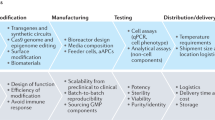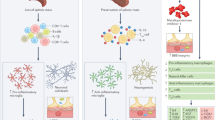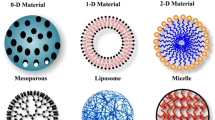Abstract
The potential therapeutic applications of encapsulated cells are enormous. In the US alone, it has been estimated that nearly half-a-trillion dollars are spent each year to care for patients who suffer tissue loss or dysfunction. Over 6 million patients suffer from neurodegenerative disorders such as Alzheimer's disease and Parkinson's disease, over 14 million patients suffer from diabetes, and millions more from liver failure, hemophilia, and other diseases caused by the loss of specific vital cellular functions. It appears likely that by the end of the decade clinical trials of encapsulated cells to treat many of these diseases will become a reality. The Food and Drug Administration has already authorized studies to evaluate the safety and biological activity of several types of systems. A number of issues will have to be addressed, including the sourcing of raw materials, the design and building of manufacturing facilities, the scale-up and optimization process, storage and distribution of the product, and quality control.
This is a preview of subscription content, access via your institution
Access options
Subscribe to this journal
Receive 12 print issues and online access
$209.00 per year
only $17.42 per issue
Buy this article
- Purchase on Springer Link
- Instant access to full article PDF
Prices may be subject to local taxes which are calculated during checkout
Similar content being viewed by others
References
Lanza, R.P. and Chick, W.L. 1995. Encapsulated cell therapy. Scientific American Science & Medicine. 2: 16–25.
Lanza, R.P. and Chick, W.L. (eds.). 1994. Pancreatic islet transplantation: Volume III Immunoisolation of pancreatic islets. Landes/CRC Press. Austin, TX.
Lanza, R.P. and Chick, W.L. 1995. Encapsulated cell transplantation. Transplantation Reviews 9: 217–230.
Soon-Shiong, P., Lu, Z.N., Grewal, I., Lanza, R.P., and Clark, W. 1990. An in vitro method of assessing the immunoprotective properties of microcapsule membranes using pancreatic and tumor cell targets. Transient Proc. 22: 754–755.
Darquy, S. and Reach, G. 1985. Immunoisolation of pancreatic β cells by micro-encapsulation. Diabetologia 28: 776–780.
Lanza, R.P., Kühtreiber, W.M., Ecker, D., Staruk, J.E., and Chick, W.L. 1995. Xenotransplantation of porcine and bovine islets without immunosuppression using uncoated alginate microspheres. Transplantation 59: 1377–1384.
Mito, M. and Sawa, M. 1996. Hepatocyte transplantation, pp. 127–133 in 1996/97 Yearbook of cell and tissue transplantation. Lanza, R.P. and Chick, W.L. (eds.). Kluwer Academic Press, Dordrecht, the Netherlands.
Yang, M.D., Vacanti, J.P., and Ingber, D.E. 1994. Hollow fibers for hepatocyte encapsulation and transplantation: Studies of survival and function in rats. Cell Transplant. 3: 373–385.
Jauregui, H.O., Mullon, C.J-P., and Solomon, B.A. 1996. Extracorporeal artificial liver support, in Principles of tissue engineering. Lanza, R.R, Langer, R., and Chick, W.L. (eds.). Landes/Academic Press, Austin, TX.
Eguchi, S., Chen, S., Rozga, J., and Demetriou, A.A. 1996. Tissue engineering/ hybrid tissues: liver, pp. 247–252 in 1996/97 Yearbook of cell and tissue transplantation. Lanza, R.R and Chick, W.L. (eds.). Kluwer Academic Press. Dordrecht, the Netherlands.
Cai, Z.H., Shi, Z.Q., Sherman, M., and Sun, A.M. 1989. Development and evaluation of a system of microencapsulation of primary rat hepatocytes. Hepatology 10: 855–860.
Sun, A.M., Cai, Z., Shi, Z., Ma, F., and O'Shea, G.M. 1987. Microencapsulated hepatocytes: an in vitro and in vivo study. Biomat Art. Cells Art. Org. 15: 1483–1496.
Sagen, J. 1996. Chromaffin cell transplantation, pp. 71–89 in 1996/97 Yearbook of cell and tissue transplantation. Lanza, R.P. and Chick, W.L. (eds.). Kluwer Academic Press. Dordrecht, the Netherlands.
Roberts, H.R. 1989. The treatment of hemophilia: past tragedy and future promise. N. Engl. J. Med. 321: 1188–1190.
Chang, P.L., Shen, N., and Westcott, A.J. 1993. Delivery of recombinant gene products with microencapsulated cells in vivo. Hum. Gene Ther. 4: 433–440.
Aebischer, P. and Lysaght, M.J. 1995. Immunoisolation and cellular xenotrans-plantation. Xeno. 3: 43–48.
Ezzell, C. 1995. Tissue engineering and the human body shop: encapsulated-cell transplants enter the clinic. J. NIH Research 7: 47–51.
Tresco, P.A., Winn, S.R., and Aebischer, P. 1992. Polymer encapsulated neuro-transmitter secreting cells. Potiential treatment for Parkinson's disease. ASAIO J 38: 17–23.
Freed, W.J. 1996. Neural transplantation: brain, pp. 163–173 in 1996/97 Yearbook of cell and tissue transplantation. Lanza, R.P and Chick, W.L. (eds.). Kluwer Academic Press. Dordrecht, the Netherlands.
Widner, H., Brundin, J., Rehncroma, S., Gustavii, B., Frackowiak, R., Leenders, K.L., et al. 1991. Transplanted allogeneic fetal dopamine neurons survive and improve motor function in idiopathic Parkinson's Disease. Transplant Proc. 23: 793–795.
Aebischer, P., Goddard, M., Signore, A.P., and Timpson, R.L. 1994. Functional recovery in hemiparkinsonian primates transplanted with polymer-encapsulated PC12 cells. Exp. Neurol. 126: 151–158.
Phelps, C.H., Gage, F.H., Growdon, J.H., Hefti, F., Harbaugh, R., Johnston, M.V., et al. 1989. Potential use of nerve growth factor to treat Alzheimer's disease. Neurobiol. of Aging 10: 205–207.
Hoffman, D., Breakefield, X.O., Short, M.P., et al. 1993. Transplantation of a polymer-encapsulated cell line genetically engineered to release NGF. Exp. Neurol. 122: 100–106.
Soon-Shiong, P., Heintz, R.E., Merideth, N., Yao, Q.X., Yao, Z., Zheng, T., et al. 1994. Insulin independence in a type 1 diabetic patient after encapsulated islet transplantation. Lancet 143: 950–951.
Calafiore, R. 1992. Transplantation of microencapsulated pancreatic human islets for therapy of diabetes mellitus. ASAIO J. 38: 34–37.
Sharp, D.W., Swanson, C.J., Olack, B.J., et al. 1994. Protection of encapsulated human islets implanted without immunosuppression in patients with type I or type II diabetes and in nondiabetic control subjects. Diabetes 43: 1167–1170.
Aebischer, P., Buchser, E., Joseph, J.M., Favre, J., de Tribolet, N., Lysaght, M., et al. 1994. Transplantation in humans of encapsulated xenogeneic cells without immunosuppression. Transplantation 58: 1275–1277.
Ezzell, C. 1987. Tissue engineering and the human body shop: encapsulated-cell transplants enter the clinic. J. NIH Research 7: 47–51.
Matsumura, K.N., Guevara, G.R., Huston, H. et al. 1987. Hybrid bioartificial liver in hepatic failure: Preliminary clinical report. Surgery 101: 151–157.
Sutherland, D.E.R., Gruessner, R.W.G., and Gores, P.F. 1994. Pancreas and islet transplantation. Transplant Rev. 8: 185–206.
Gores, P.E. and Sutherland, D.E.R. 1994. Immunosuppression for islet transplantation, pp. 63–74 in Pancreatic islet transplantation: volume II immunomodulation of pancreatic islets. Lanza, R.P. and Chick, W.L. (eds.). Landes/CRC Press. Austin, TX.
Hering, B.J., Geier, C., Schultz, A.O., Bretzel, R.G., and Federlin, K. International islet transplant registry. Presented at the 14th AIDSPIT Meeting, January 1995, Igls, Austria.
Kahan, B.D. 1989. Cyclosporine. N. Engl. J. Med. 321: 1725–1738.
Fung, J.J., Alessiani, M., Abu-Elmagd, K., Todo, S., Shapiro, R., Tzakis, A., et al. 1992. Adverse effects associated with the use of FK 506. Transplant Proc. 23: 3105–3108.
Gunnarsson, R., et al. 1983. Deterioration in glucose metabolism in pancreatic transplant recipients given cyclosporin. Lancet 2: 571–572.
Alejandro, R., Feldman, E.C., Bloom, A.D., and Kenyon, N.S. 1989. Effects of cyclosporin on insulin and C-peptide secretion in healthy beagles. Diabetes 38: 698–703.
Schlumpf, R., Largiader, F., Uhlschmid, G.K., and Baumgartner, D. 1986. Is cyclosporine toxic for transplanted pancreatic islets? Transplant Proc. 28: 1169–1170.
Van Schilfgaarde, R., van der Burg, M.P.M., van Suylichem, H.G., Goosen, H.G., and Frolich, M. 1986. Does cyclosporin influence beta cell function? Transplant Proc. 28: 1175–1176.
Lanza, R.P., Sullivan, S.J., and Chick, W.L. 1992. Islet transplantation with immunoisolation. Diabetes 41: 1503–1510.
Chick, W.L., Perna, J.J., Lauris, V., Low, D., Galletti, P.M., Panol, G., et al. 1977. Artificial pancreas using live β-cells: Effects of glucose homeostasis in diabetic rats. Science 197: 780–782.
Tze, W.J., Wong, F.C., and Chen, I.M. 1976. Implantable artificial endocrine pancreas unit used to restore normoglycemia in the diabetic rat. Nature 264: 466–467.
Whittemore, A.D., Chick, W.L., Galletti, P.M., Like, A.A., Colton, C.K., Lysaght, M.J., et al. 1977. Effects of the hybrid artificial pancreas in diabetic rats. Trans. Am. Soc. Artif. Intern. Organs 13: 336–340.
Sun, A.M., Parisius, W., Healy, G.M., Vacek, I., and Macmorine, H.G. 1977. The use in diabetic rats and monkeys of artificial capillary units containing cultured islets of Langerhans. Diabetes 26: 1136–1139.
Feldman, S., Dodi, G., Haid, K., Scharp, D.W., Ballinger, W., and Lacy, P.E. 1977. Artificial hybrid pancreas. Surg. Forum 28: 439–442.
Tze, W.J., Wong, F.C., and Chen, L.M. 1979. Implantable artificial capillary unit for pancreatic islet allograft and xenograft. Diabetologia 16: 247–252.
Sun, A.M., Parisius, W., MacMorine, H.G., Sefton, M. and Stone, R. 1980. An artificial endocrine pancreas containing cultured islets of Langerhans. Artif. Organs 4: 275–278.
Lanza, R.P., Solomon, B.A., Monaco, A.P. and Chick, W.L. 1994. Devices implanted as AV shunts, pp. 154–168 in Pancreatic islet transplantation: volume III immunoisolation of pancreatic islets. Lanza, R.P. and Chick, W.L. (eds.). Landes/CRC Press. Austin, TX.
Sullivan, S.J., Maki, T., Borland, K.M., Mahoney, M.D., Solomon, B.A., Muller, T.E., et al. 1991. Biohybrid artificial pancreas: Long-term implantation studies in diabetic, pancreatectomized dogs. Science 252: 718–721.
Maki, T., Otsu, I., O'Neil, J.J., Dunleavy, K., Mullon, C.J.P., Solomon, B.A., and Monaco, A.P. 1996. Treatment of diabetes by xenogeneic islets without immunosuppression. Diabetes 45: 342–347.
Colton, C.K. 1995. Implantable biohybrid artificial organs. Cell Transplant 4: 415–436.
Lanza, R.P. and Chick, W.L. 1994. Introduction, pp. 1–12 in Pancreatic islet transplantation: volume III immunoisolation of pancreatic islets. Lanza, R.P. and Chick, W.L. (eds.). Landes/CRC Press. Austin, TX.
Lanza, R.P., Butler, D.H., Borland, K.M., Staruk, J.E., Faustman, D.L., Solomon, B.A., et al. 1991. Xenotransplantation of canine, bovine, and porcine islets in diabetic rats without immunosuppression. Proc. Natl. Acad. Sci. USA 88: 11100–11104.
Lanza, R.P., Borland, K.M., Lodge, P., Carretta, M., Sullivan, S.J., Muller, T.E., et al. 1992. Treatment of severely diabetic, pancreatectomized dogs using a diffusion-based hybrid pancreas. Diabetes 41: 886–889.
Lanza, R.P., Borland, K.M., Staruk, J.E., Appel, M.C., Solomon, B.A., and Chick, W.L. 1992. Transplantation of encapsulated canine islets into spontaneously diabetic BB/Wor rats without immunosuppression. Endocrinology 131: 637–642.
Lanza, R.P., Beyer, A.M., Staruk, J.E., and Chick, W.L. 1993. Biohybrid artificial pancreas: longterm function of discordant islet xenografts in streptozotocin diabetic rats. Transplantation 56: 1067–1072.
Andersson, A. 1979. Survival of pancreatic islet allografts. Lancet 2: 585.
Theodorou, N.A. and Howell, S. 1979. An assessment of diffusion chambers for use in pancreatic islet cell transplantation. Transplantation 27: 350–352.
Lim, F. and Sun, A.M. 1980. Microencapsulated islets as bioartificial endocrine pancreas. Science 210: 908–910.
O'Shea, G.M., Goosen, M.F.A., and Sun, A.M. 1984. Prolonged survival of transplanted islets of Langerhans encapsulated in a biocompatible membrane. Biochim. Biophys. Acta. 804: 133–136.
Wang, Y., Hao, L., Gill, R., and Lafferty, K.J. 1987. Autoimmune diabetes in NOD mouse is L3T4 T-lymphocyte dependent. Diabetes 36: 535–538.
Calafiore, R., Janjic, D., Koh, N., and Alejandro, R. 1987. Transplantation of microencapsulated canine islets into NOD mice: prolongation of survival with superoxide dismutase and catalase. Clin. Res. 35: 499A.
Ricker, A., Bhatia, V., Bonner-Weir, S., and Eisenbarth, G. 1987. Microencapsulated xenogeneic islet grafts in NOD mouse; dexamethasone and inflammatory response. Cold Spring Harbor Symposium, October, p. 53A.
Platt, J.L. and Bach, F.H. 1991. The barrier to Xenotransplantation. Transplantation 52: 937.
Lanza, R.P., Ecker, D., Kühtreiber, W.M., Staruk, J.E., Marsh, J., and Chick, W.L. 1995. A simple method for transplanting discordant islets into rats using alginate gel spheres. Transplantation 59: 1486–1487.
Soon-Shiong, P., Feldman, E., Nelson, R., Heintz, R., Yao, Q., Yao, Z., et al. 1993. Long-term reversal of diabetes by the injection of immunoprotected islets. Proc. Natl. Acad. Sci. USA 90: 5843–5847.
Author information
Authors and Affiliations
Rights and permissions
About this article
Cite this article
Lanza, R., Hayes, J. & Chick, W. Encapsulated cell technology. Nat Biotechnol 14, 1107–1111 (1996). https://doi.org/10.1038/nbt0996-1107
Received:
Accepted:
Issue Date:
DOI: https://doi.org/10.1038/nbt0996-1107
This article is cited by
-
Recent Advancements and Associated Challenges of Scaffold Fabrication Techniques in Tissue Engineering Applications
Regenerative Engineering and Translational Medicine (2021)
-
Encapsulation Strategies for Pancreatic Islet Transplantation without Immune Suppression
Current Stem Cell Reports (2021)
-
Hope vs hype: where are we in type 1 diabetes?
Diabetologia (2018)
-
Managing diabetes with nanomedicine: challenges and opportunities
Nature Reviews Drug Discovery (2015)
-
A new validation method for clinical grade micro-encapsulation: quantitative high speed video analysis of alginate capsule
Microsystem Technologies (2015)



